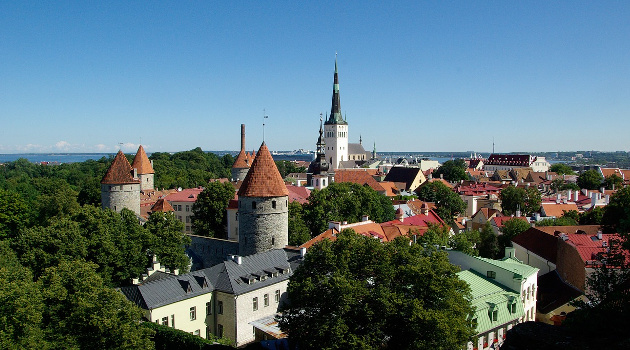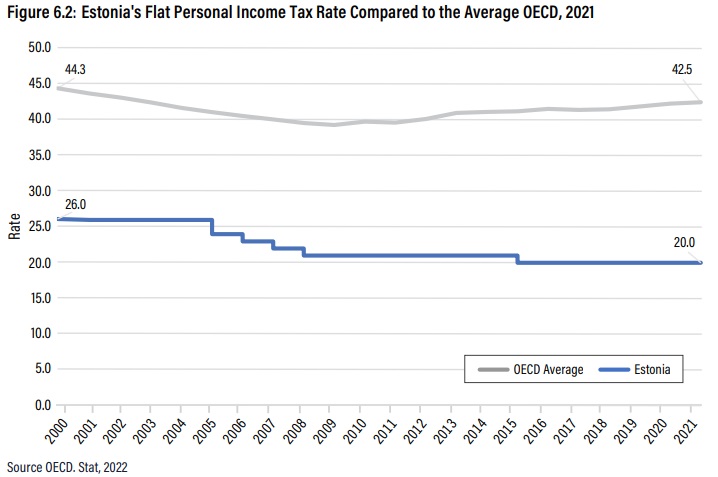I’m in Estonia as part of the Free Market Road Show, so this is a good opportunity for Part III of my series on that country’s rebound from communism.
To follow up on Part I and Part II, let’s start with this Fraser Institute video.
I’ve always been a fan of Estonia, going all the way back to the 1990s when Mart Laar, a history professor, became the nation’s first post-communist leader and copied the ideas of Milton Friedman with reforms such as the flat tax.
- The good news is that the rate of the flat tax has declined from where it started at 26 percent.
- The bad news is that rate just increased from 20 percent in 2024 to 22 percent in 2025.
But that’s still much better than income tax rates in other European nations. And Estonia’s overall tax system ranks as the best among all OECD nations.
Another way of gauging Estonia’s success is to review how well it is doing compared to other nations that emerged when the Soviet Union collapsed.
I’ve already shared data showing Estonia being a star performer, so let’s look at excerpts from Matt Mitchell’s column comparing market-oriented Estonia with statist Russia.
Estonia is…an uncomfortable reminder to Russians of what could have been. …Since leaving the Soviet Union in 1991, Estonia has grown faster than any former Soviet state. Today, the typical Estonian earns nearly 40 percent more than the typical Russian. The share of Estonians living in poverty is one-sixth that in Russia. Relative to its population, Estonia has 50 times (!) as many business startups as Russia… An Estonian can expect to live eight years longer than a Russian. Estonian infants die at less than half the rate of Russian infants. Estonians are far more likely to report satisfaction with their lives (ranking 38 slots ahead of Russia) and government services. Estonia has one of the lowest perceptions of corruption globally (tied with Canada, Iceland and Uruguay at 14th; Russia ranks 137th out of 180 countries). …How did this happen? …Once Estonia left the Soviet Union, it embarked on a seemingly radical plan to free its people and economy. …Estonia’s leaders privatized every business they could. They reduced government spending and consistently balanced the budget. They introduced the world’s first flat personal income tax at half the rate of other industrialized countries. They stabilized the growth rate of their money supply to bring inflation under control. They reduced regulations and made it easier to start businesses. Almost unprecedented in the modern era, they unilaterally eliminated all tariffs and barriers to trade, giving their people proper access to the global marketplace.
All that is very impressive. The country is moving in the right direction.
Indeed, Estonia should be a role model for other post-Soviet nations, as Andy Kessler explained last year for the Wall Street Journal.
“You can’t bribe a computer,” Estonian Prime Minister Kaja Kallas told me. When it’s time to rebuild, Ukrainian President Volodymyr Zelensky should heed these words. …Ms. Kallas noted her government uses these digital tools “to decrease, diminish bureaucracy.” That’s how to create small government. “It’s cheaper and our debt is much lower as well.” Though it’s rising, Estonia still has the lowest ratio of government debt to gross domestic product in the EU. …the Reagan playbook is working. …Estonia is working to increase everyone’s equity value. Purchasing power is up 400% since Soviet occupation… Free trade, low taxes, small government, e-services, educated workers, low debt and negligible corruption. Ukraine—and the U.S.—can learn a lot from Estonia.
I’ll close by shifting to pessimism.
Estonia has not made much progress on further liberalization in the past 10-15 years, and it’s overall ranking for economic freedom has dropped to #20. Not bad by global standards, but Estonia should strive to be at Swiss levels (#3 in the world) of economic liberty.
And there are other challenges, such as the demographic decline that I wrote about back in 2016.
P.S. In Estonia’s defense, the main reason for the recent decline in economic freedom is bad monetary policy, but that’s the fault of the European Central Bank (and it’s grossly incompetent head bureaucrat) in Frankfurt.
———
Image credit: NakNakNak | Pixabay License.




